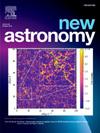翘曲吸积盘粘度幂律模型
IF 2.1
4区 物理与天体物理
Q2 ASTRONOMY & ASTROPHYSICS
引用次数: 0
摘要
在本文中,我们用数值方法研究了由于黑洞自旋而扭曲的薄吸积盘。我们假设两个黏度系数根据幂律模型随半径变化,各有不同的幂指数。此外,我们通过应用适当的边界条件来考虑内盘的贡献。结果表明,黏度的幂指数(n和α1)对圆盘的排列有影响。具体而言,垂直粘度指数比方位粘度指数的影响更大。垂直粘度指数的增加导致圆盘与黑洞自转轴的更大偏差。这些发现表明,与之前的研究相反,盘的内部区域可以相对于黑洞的旋转轴保持倾斜,即使对于具有较大Kerr参数的旋转黑洞,特别是a = 0.3。我们的研究结果有助于解释观测到的x射线辐射和Fe - k - α线的准周期振荡特征,这可能是由扭曲的内部吸积盘进动引起的。这项研究可能对探索强引力场区域有价值。本文章由计算机程序翻译,如有差异,请以英文原文为准。
Warped accretion disk with power-law models for viscosities
In this paper, we investigate a thin accretion disk that is warped due to the Black hole spin using numerical methods. We assume that the two viscosity coefficients vary with radius according to a power-law model, each with different power indices. Additionally, we consider the contribution of the inner disk by applying the appropriate boundary condition. Our results indicate that the alignment of the disk is influenced by the power indices of the viscosities (n and α1). Specifically, the vertical viscosity index is more influential than the azimuthal viscosity index. An increase in the vertical viscosity index leads to greater misalignment of the disk concerning the spin axis of the black hole. These findings suggest that, contrary to previous studies, the inner regions of the disk can remain tilted relative to the rotation axis of the black hole, even for rotating black holes with a larger Kerr parameter, specifically, a = 0.3. Our results help explain the observed quasi-periodic oscillation features in X-ray emissions and the Fe Kα line, which may arise from the precession of a warped inner accretion disk. This research could be valuable for exploring regions of strong gravitational fields.
求助全文
通过发布文献求助,成功后即可免费获取论文全文。
去求助
来源期刊

New Astronomy
地学天文-天文与天体物理
CiteScore
4.00
自引率
10.00%
发文量
109
审稿时长
13.6 weeks
期刊介绍:
New Astronomy publishes articles in all fields of astronomy and astrophysics, with a particular focus on computational astronomy: mathematical and astronomy techniques and methodology, simulations, modelling and numerical results and computational techniques in instrumentation.
New Astronomy includes full length research articles and review articles. The journal covers solar, stellar, galactic and extragalactic astronomy and astrophysics. It reports on original research in all wavelength bands, ranging from radio to gamma-ray.
 求助内容:
求助内容: 应助结果提醒方式:
应助结果提醒方式:


